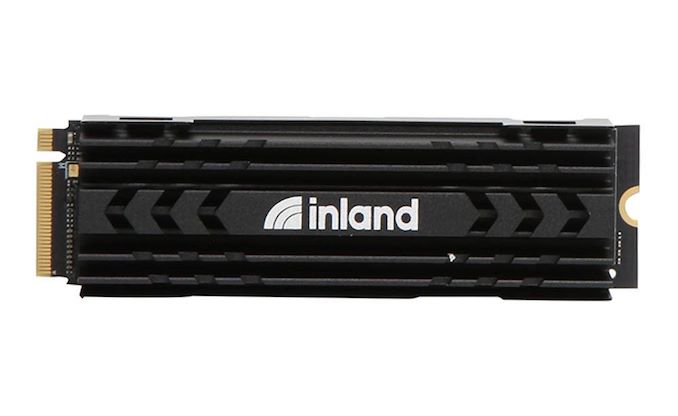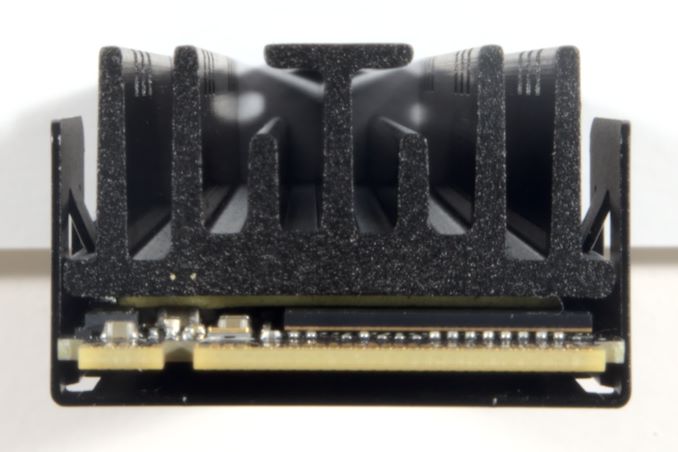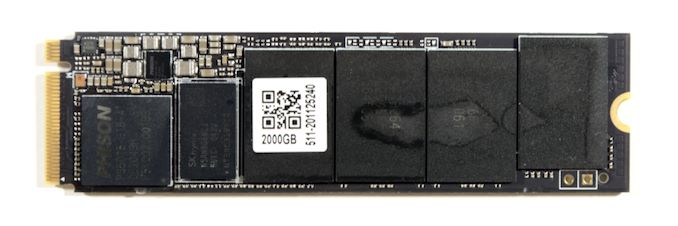The Inland Performance Plus 2TB SSD Review: Phison's E18 NVMe Controller Tested
by Billy Tallis on May 13, 2021 8:00 AM EST
Phison kicked off the transition to PCIe 4.0 for storage in 2019, and dominated the high-end SSD market for over a year with the only available PCIe 4.0 solution. There are now several competing PCIe 4.0 NVMe SSDs and controllers that handily outperform the Phison E16, but Phison has stayed competitive by bringing out a second-generation PCIe 4.0 controller, the E18. Today we're looking at one of many drives built around that controller: the Inland Performance Plus 2TB.
The Inland brand is owned by the parent company of American retailer Micro Center. Most or all Inland-branded SSDs are simply Phison reference designs with little or no customization beyond cosmetics. Inland SSDs are frequently great value options—especially for Micro Center's in-store only deals, but even their online prices tend to be very competitive. Part of the discount comes from their tendency toward shorter warranty periods: the Inland Performance Plus has only a three year warranty despite being a high-end flagship model. Fortunately, the total write endurance rating is the same as competing drives that carry five year warranties, and the SSD hardware itself is identical to other brands selling the same SSD reference design under different heatsinks and labels.
As part of the second wave of PCIe 4.0 SSD controllers, the Phison E18 aims to use substantially all of the performance available from the PCIe 4.0 x4 interface: sequential transfers up to around 7.4 GB/s and random IO up to about 1M IOPS. Hitting that level of performance while staying within M.2 power delivery and thermal dissipation limits required migrating to 12nm FinFET fabrication from the cheaper 28nm widely used by PCIe 3.0 SSD controllers and by the Phison E16. But even so, the Phison E18 can draw more power than the E16 controller because the increase in performance is so large. Competition for the Phison E18 includes in-house controllers used in the latest flagship consumer SSDs from Samsung and Western Digital, newcomer Innogrit's IG5236 Rainier controller, and Silicon Motion's upcoming SM2264 controller.
| Phison High-End NVMe SSD Controller Comparsion | |||||||
| E12 | E16 | E18 | |||||
| Manufacturing Process | 28 nm | 12 nm | |||||
| CPU Cores | 2x Cortex R5 | 3x Cortex R5 | |||||
| Error Correction | 3rd Gen LDPC | 4th Gen LDPC | |||||
| DRAM | DDR3/4 | DDR4 | DDR4, LPDDR4 | ||||
| Host Interface | PCIe 3.0 x4 | PCIe 4.0 x4 | |||||
| NVMe Version | NVMe 1.3 | NVMe 1.4 | |||||
| NAND Channels, Interface Speed |
8 ch, 667 MT/s |
8 ch, 800 MT/s |
8 ch, 1600 MT/s |
||||
| Max Capacity | 16 TB | 16 TB | 16 TB | ||||
| Sequential Read | 3.4 GB/s | 5.0 GB/s | 7.4 GB/s | ||||
| Sequential Write | 3.2 GB/s | 4.4 GB/s | 7.0 GB/s | ||||
| 4KB Random Read IOPS | 700k | 750k | 1M IOPS | ||||
| 4KB Random Write IOPS | 600k | 750k | 1M IOPS | ||||
| Controller Power | 2.1 W | 2.6 W | 3.0 W | ||||
| Sampling | Q2 2018 | Q1 2019 | Q1 2020 | ||||
| Retail SSD Availability | Q4 2018 | Q3 2019 | Q4 2020 | ||||
The Inland Performance Plus does not quite hit the theoretical limits of the Phison E18 controller. The 1TB model is clearly handicapped on some performance metrics compared to the 2TB model, but even the latter is only rated for 7GB/s sequential reads and 650-700k IOPS instead of 7.4GB/s and 1M IOPS. This mostly comes down to the Inland Performance Plus and other current E18 drives using 96L TLC NAND with 1200MT/s IO between the NAND and the controller, while the E18 can support up to 1600MT/s IO. A new round of E18-based products will start hitting the market soon using Micron 176L TLC that operates with the higher IO speed and should bring some other performance and efficiency improvements. We expect some of these new drives to be announced at Computex next month.
| Inland Performance Plus SSD Specifications |
||||
| Capacity | 1 TB | 2 TB | ||
| Form Factor | M.2 2280 PCIe 4.0 x4 | |||
| Controller | Phison E18 | |||
| NAND Flash | Micron 96L 3D TLC | |||
| Sequential Read (GB/s) | 7.0 | 7.0 | ||
| Sequential Write (GB/s) | 5.5 | 6.85 | ||
| Random Read IOPS (4kB) | 350k | 650k | ||
| Random Write IOPS (4kB) | 700k | 700k | ||
| Warranty | 3 years | |||
| Write Endurance | 700 TB 0.6 DWPD |
1400 TB 0.6 DWPD |
||
| Retail Price (In Store Only) | $189.99 (19¢/GB) |
$379.99 (19¢/GB) |
||
Like most drives using the Phison E18 controller, the Inland Performance Plus comes with a fairly substantial heatsink installed. The controller package is small enough to share space with a DRAM package and four NAND packages on the front of the PCB, which means there's a lot of heat concentrated in a small area. (The Inland Performance Plus also has DRAM and NAND on the back of the PCB.) PCIe 4.0 has barely started showing up in laptops and using the full performance of a drive like the Inland Performance Plus requires more power than most laptops are able to sink away from their M.2 slots, so it's reasonable to regard this drive as pretty much desktop-only.
The Competition
The most important competitors for the Inland Performance Plus are other Phison E18 drives and the current flagship PCIe 4.0 drives from Samsung and Western Digital. We have fresh results in this review for the Samsung 980 PRO, retested with the latest 3B2QGXA7 firmware. We've also included results from some older top of the line drives: the Intel Optane 905P and Samsung 970 PRO (their last consumer NVMe drive to use MLC NAND), and the Silicon Power US70 representing the first wave of PCIe 4.0 drives that used the Phison E16 controller.
| WD Black SN850 | PCIe 4.0 x4 | WD Custom G1 | 96L TLC |
| Samsung 980 PRO | PCIe 4.0 x4 | Samsung Elpis | 128L TLC |
| Silicon Power US70 | PCIe 4.0 x4 | Phison E16 | 96L TLC |
| Intel Optane SSD 905P | PCIe 3.0 x4 | Intel Custom | 3D XPoint G1 |
| Samsung 970 PRO | PCIe 3.0 x4 | Samsung Phoenix | 64L MLC |
The rest of the drives included in this review are more mainstream models, mostly PCIe 3.0 drives, some with four-channel controllers instead of the usual eight for the high-end, and even a few with QLC NAND. This includes the Inland Premium, which is based on the Phison E12S and TLC NAND.
| Inland Premium | PCIe 3.0 x4 | Phison E12S | 96L TLC |
| SK hynix Gold P31 | PCIe 3.0 x4 | SK hynix Custom (4ch) | 128L TLC |
| Samsung 970 EVO Plus | PCIe 3.0 x4 | Samsung Phoenix | 92L TLC |
| WD Black SN750 | PCIe 3.0 x4 | WD Custom G1 | 64L TLC |
| HP EX950 | PCIe 3.0 x4 | SM2262EN | 64L TLC |
| Kingston KC2500 | PCIe 3.0 x4 | SM2262EN | 96L TLC |
| Intel SSD 670p | PCIe 3.0 x4 | SM2265 (4ch) | 144L QLC |
| ADATA Gammix S50 Lite | PCIe 4.0 x4 | SM2267 (4ch) | 96L TLC |
| Corsair MP600 CORE | PCIe 4.0 x4 | Phison E16 | 96L QLC |

















118 Comments
View All Comments
DominionSeraph - Thursday, May 13, 2021 - link
Try an optimized OS like XP. There's really no difference.philehidiot - Thursday, May 13, 2021 - link
I do actually have windows 95 installed as a VM, running off an SSD. If you want to really understand how bloated and sluggish Windows 10 is, try using Windows 95 and see how far they have regressed in pursuit of looking pretty.GeoffreyA - Friday, May 14, 2021 - link
Even XP feels faster, on an older computer, than 10. Vista is where the sluggishness crept in.GeoffreyA - Friday, May 14, 2021 - link
Also, software in general has become more sluggish, owing to excessive use of abstractions, frameworks, and modern languages.jospoortvliet - Friday, May 14, 2021 - link
Software has become vastly more complex as users demand more and more features and slick interfaces. Also, platforms evolve faster and more need to be supported. Developers have less time per feature so more abstractions and higher level languages are needed. You can't write code in a browser that is as efficient as good old assembly as it has to run everywhere and even if you could you would lose to a competitor who wrote more features with less developers....So yeah, you are right but it is a trend that is hard to reverse.
GeoffreyA - Friday, May 14, 2021 - link
Quite true, but one can't help feeling a pang of regret when looking at today's applications vs. those rare C/C++ Win32 ones that, as they say, just fly.FunBunny2 - Saturday, May 15, 2021 - link
"Quite true, but one can't help feeling a pang of regret when looking at today's applications vs. those rare C/C++ Win32 ones that, as they say, just fly."true fact. I used 1-2-3 pretty much from version 1, which is X86 assembler as was DOS. somewhere around 2.4 it was re-written in C (C++ didn't yet exist). the first time I fired up 2.4 1-2-3 (on a 640K 8088) what had been instant screen updates were now slow as molasses up hill in winter; you could see individual elements change, one by one.
it appears to be the fact that the constant push and pull between node shrink, more transistors, phatter cpu, more memory on the one hand and software bloat on the other doesn't balance out. I've always been sceptical of ever-increasing number of 'tiers' in the memory hierarchy paired with load-store architectures. may haps persistent memory will give us a true Single Level Storage that's more performant than just virtual storage/memory. have to work out a new version of transaction control, though.
GeoffreyA - Saturday, May 15, 2021 - link
Well, soon they'll need some big changes, when the quantum limits set by Nature are hit. As for the software, yes, it tends to get slower as time goes by. Any gains in hardware are quickly reversed. I think there's been a view inculcated against C++, instigated by Java perhaps, that it's not safe, it's bad, and so one needs to use a better, more modern language; or if C++, do things in an excessive object-oriented way, away from the lighter C sort of style. As in all of life, even "good" programming principles can be taken too far. So moderation is best.FunBunny2 - Saturday, May 15, 2021 - link
"if C++, do things in an excessive object-oriented way, away from the lighter C sort of style."C has been described as the universal assembler. pretty much true, esp. if you limit the description to the bare language w/o the many libraries. a C program can be blazingly fast, if the code treats the machine as a Control Program would. but that's how the PC World was nearly extinguished in the late 80s and early 90s by viruses of all kinds. I'm among those who spent more time than I wanted, editing with Norton Disk Doctor. not an era I miss.
GeoffreyA - Sunday, May 16, 2021 - link
Oh, yes, programs were doing their own thing, till OS's began to clamp down. As years went by, security got more attention too, as it should, and newer languages guaranteed different types of safety. An important point in this era where so much of our information is handled electronically. Or portability made easier, or maintenance.